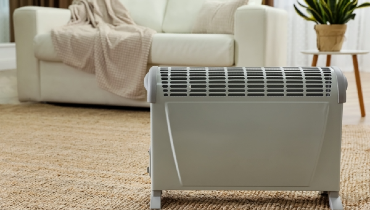Supplemental Heating Types for Your Home

Keeping your home evenly heated in the colder months can be a struggle for your wallet and your toes. Despite having a sufficient main heating system, sometimes cranking up the temperature only seems to increase the energy bill and not the warmth. For this reason, many homeowners instead rely on supplemental or alternative heating systems to have more narrowed heating control.
If you’re considering adding a supplemental heating source to your home, and curious about the many options, look no further! We have some helpful insights.
What Is Supplemental Heating?
Supplemental heating sources like radiators, space heaters, and fireplaces are alternative options to simply turning up the heat in your home or installing a new, main heating system.
By using these alternative heating sources, you can heat specific rooms or areas of your home that are most often used. That way, you can keep warm and not overwork your main heating system.
Why Do I Need Supplemental Heating?
Many homeowners turn to supplemental heating during the colder months when finding a warm spot in your home can seem like a scavenger hunt.
However, there are many other reasons to consider this option including:
- Your home temperature is inconsistent.
- Your main heating system isn’t sufficient enough in colder months.
- You want to avoid frozen pipes in poorly heated areas.
- You have a new home addition that needs added heating.
And other benefits such as:
- Less energy is wasted due to more selective heating.
- Energy costs decrease because your main system isn’t overworked.
- Options are flexible in design, and most have minimal (if any) installation.
Related Topic:Keep Your House Warm During a Power Outage
What Are the Best Supplemental Heat Types for Your Home?
There are a wide variety of options to choose from—some of which better complement certain existing heating systems over others. There are also differences within each system such as fuel type, installation, and design.
- Electric radiators. Depending on the size of the space that needs heating, one or two electric radiators can be installed. Temperature can be controlled individually, and most don’t take up a lot of space. Other radiator types include steam heat and hot water—but these options require a boiler, and therefore a larger investment to consider.
- Radiant floor heating. Using heat radiation, this system feels more like the heat of the sun, providing comfortable heating throughout your home. Installation can be intensive, though, since flooring will need to be re-installed or replaced depending on the system type. This system is either powered by electric heating coils or water-heated tubing. The latter needs a boiler for installation as well.
- Electric space heaters. Their portability and size make them a very cost-effective and flexible option. However, their radius of heat output isn’t very large, and they aren’t meant to run for a long period of time unless you’re using a permanently installed convectional heater. For any space heater, make sure you first review our space heater safety tips.
- Gas fireplaces. For a more permanent option, gas fireplaces can help to significantly heat a larger space in your home. However, vented options require more intensive installation, and ventless, while flexible in installation, require a time-limited operation.
- Electric fireplaces. A more permanent and stylish option that’s fairly quick to install. However, because they don’t offer much more heat output than a space heater, they’re ideal for a main room.
- Wood fireplaces. Needing proper ventilation, a wood fireplace can be a bit more intensive for initial installation. They also require more involved upkeep (splitting and hauling wood). But, if you experience more frequent power outages where you live, this heating source is a reliable, non-electricity-dependent option.
- Ductless mini-splits. Without any need for ductwork, mini-spits have a lot of flexibility in installation and can warm (and cool) individual rooms or smaller, open spaces. Temperature is individually controlled on each, and they can work well in conjunction with other heating systems. These systems are electrically powered.
Other Considerations Before Choosing a Supplemental Heating Option
Supplemental heating is a great way to add targeted heat to your home, but it isn’t the only solution. Especially if the amount of additional heating sources outweigh the benefits or cost of simply upgrading your main system due to the larger size or greater heating needs of your home.
Before deciding on a radiator, space heater, or fireplace make sure you’re considering these other factors:
- Maintenance on your main heating system. Sometimes heating issues can be resolved with maintenance or repairs to your main heating system. Have it checked and tuned up before purchasing supplemental heating sources.
- Energy audit. It’s possible your main heating system is working well but struggling to keep the heat inside due to poor insulation or drafty windows and doors. Once leaks or poor insulation are identified, improvements can be made that could make all the difference and save you money for decades to come.
- Your reason for wanting supplemental heating.
- Specific use. Some space heaters and gas fireplaces shouldn’t be used for long periods of time, and therefore aren’t ideal for night-time use. This attentiveness for these options as well as the labor needed to haul wood for a wood fireplace is not ideal for everyone and should be considered when choosing.
Related Topic:How to Keep a Poorly Insulated House Warm
Need Help Choose the Best Supplemental Heating?
Sick of constantly adjusting your thermostat with only a high heating bill to show for? The pros at your local Aire Serv can help by inspecting your home heating system to determine if it’s operating efficiently. If needed, we can also help you choose and install a supplemental heating source that would be the best match for you. To learn more give us a call today or schedule an appointment online today.
 Click to call
Click to call


